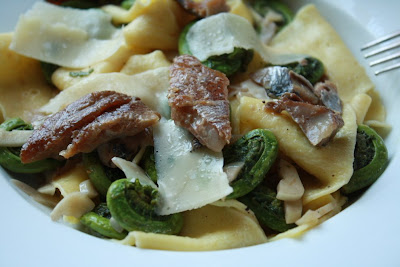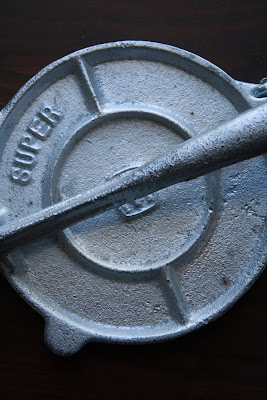At work today people kept on buying fiddleheads. Fiddleheads! Fiddleheads are one of the surest signs of Spring around here. And we had them. And people were buying them. And I wanted some. The first thing I did on my lunch break was eat lunch, but the very next thing I did was head directly to produce and look for the large, black, plastic garbage bag I knew had to be somewhere containing fiddleheads. I found it and wasted no time procuring for myself some of the springtime gems.

I knew exactly what I wanted to do with them. I wanted to saute them with lots of butter and garlic and sea salt and black pepper and toss them with fresh pasta. That is exactly what I did and it was divine. There was a hand written note complete with exclamation point attached to the large, black, plastic garbage bag, though, urging people to boil or steam their fiddleheads for 15 minutes before eating them. I headed this advice, steaming my fiddleheads for 10ish minutes, figuring they'd get a few more minutes of cooking in the saute.
As for the pasta, I had seen a recipe for seven-yolk pasta on Smitten Kitchen and wanted to try it. Thing is I only had two eggs and was only cooking for one. There are some recipes that should not be quartered and pasta is probably one of them, but I tried anyway and succeeded. I started with 2 ounces of flour, cracked one egg in the well and added another yolk. My dam quickly broke, but I managed to patch it before adding a teaspoon each of olive oil and milk. I whisked the eggs with my fingers, adding the flour a little at a time. What I was left with was very, very wet so I added more flour a soup spoon at a time until it resembled dough. I probably ended up adding at least another 2 ounces of flour if not a bit more. I kneaded it briefly and then set aside the dough to clean up my work surface. Once it was clean I dusted it again with flour and kneaded my dough for another ten minutes, adding more flour, until it was silken. I wrapped it tightly in plastic and let it sit for half an hour.
Don't let anybody tell you you have to have a pasta roller to make pasta. Which isn't to say I don't want one, but I rolled mine out with my new, beautiful rolling pin with no trouble, even managing to get it as thin as I wanted it. To cut it I simply dusted it with flour, folded it up a few times and used a knife to cut it to the desired width. I made eight noodles, which ended up being the perfect amount to feed two (and somehow I was able to restrain myself and ate only half of it).
In the past I have had trouble knowing when fresh pasta is cooked and have often taken it off the boil prematurely. Tonight I managed to cook it to perfection. Three times I tried it and three times I said, "Just a little bit longer." The fourth time I tested it, it was done. So clearly, so obviously done. So wait. You really can tell when it is cooked properly.
+wide+noodles.JPG)
I took my perfectly cooked noodles and added them to the pan containing the fiddleheads, garlic, butter, salt and pepper and tossed everything together before putting it in my bowl. I shaved a few pieces of Reggiano Parmesan (billed as the "Ferrari of the Parmesans" in our cheese department--how is a girl supposed resist that even at $15/lb?) on top with a potato peeler and sat down to dinner. And then I remembered I had half a tin of kipper snacks in the fridge and thought they'd be awfully nice with the fiddleheads and garlic and butter and salt and pepper and pasta and cheese. Which they were.

















